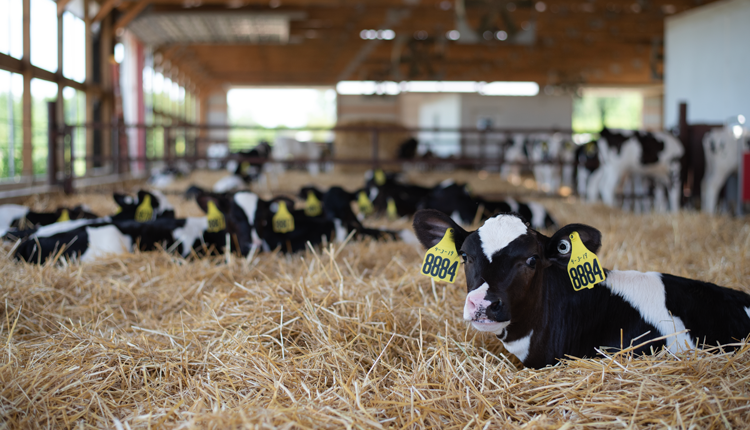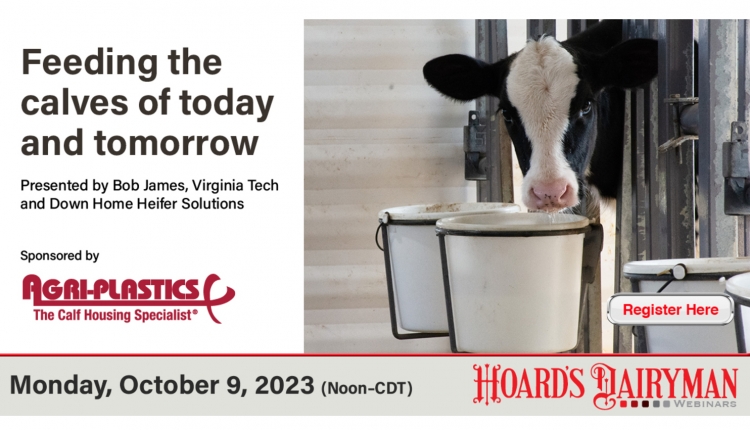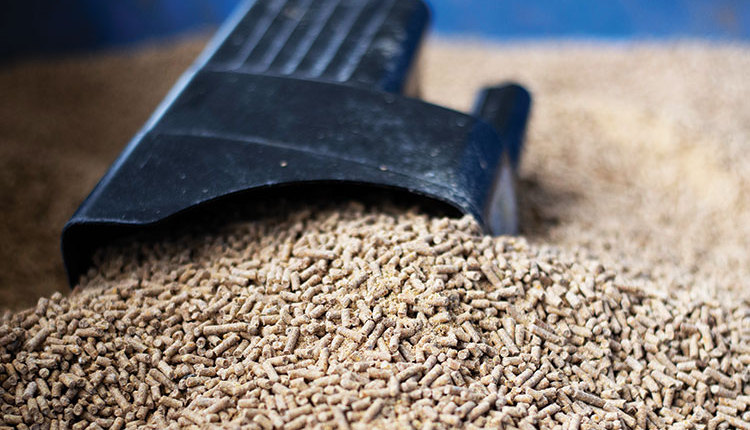The author is the principal in Adhil, LLC, a St. Louis-based consulting firm.

Calves should be fed an appropriate balance of protein and energy for best results.
Here's a look at how various replacer and starter strategies can perform.
A variety of milk or milk replacer feeding practices in the U.S. were found in the 2007 NAHMS survey. (See "Too many calf feeding mistakes being made," May 10, 2008 issue, page 343). This raises questions as to why this variety, and what are the expectations of a liquid feeding program for young calves? This may sound a bit academic, but actually it is a very practical issue.
What we should expect . . .
Unfortunately, many people do not know what calf performance in weight or height gain is because they are not measured. But there is a good method to determine what they might be. The 2001 National Research Council's Nutrient Requirements of Dairy Cattle has a young calf model which can predict daily weight gain with inputs of calf body weight, ambient temperature, and library feed values for milk replacers, milk, milk by-products, and a calf starter. If you do not find appropriate feed values, you can create your own and save them in the library to use. The balance of this article will look at a few such scenarios developed with this model.
For the model, a series of assumptions were made. They were a thermal neutral ambient temperature of 68°F, body weights (BW) were pegged at 95 pounds the first week and bumped up by 10 pounds per week thereafter, and a 20 percent protein with 20 percent fat protein (20/20) milk replacer (MR). The model predicts average daily gain (ADG) based on both the amount of dietary protein available (protein-allowable ADG) and the amount of dietary energy available (energy-allowable ADG).
Figure 1 shows the first scenario which uses the 20/20 replacer with a more traditional feeding rate of 1 pound which would be provided in twice daily feedings of 2 quarts each.
Initially, both protein and energy allowable ADGs were similar at nearly 0.6 pound for the 95-pound calf. But, as the calf gained weight, note that protein allowable ADG declined only slowly while energy ADG rapidly fell off. Why is this? It simply reflects that as the calf gets larger, maintenance requirements for that greater body weight are much greater for energy than for protein. Since energy clearly becomes the most limiting, that is what determines what the actual ADG would be . . . not the higher predicted protein ADG.
There are several possible ways to address this low ADG. The simplest is to boost the feeding rate of the 20/20 replacer from 1 pound to 1.5 pounds daily. Now, if we raise the powder feeding amount by 50 percent, we also would have to push up the volume by 50 percent. If not, the concentration, or osmolality, would climb to over 15 percent solids which can lead the calf to greater gut disturbances and risk for enterotoxemia.
Replacer more balanced . . .
Feeding 3 quarts of replacer twice daily (Figure 2) initially resulted in nearly doubling the ADG seen in Figure 1. But the pattern is now different. Initially, the energy-allowable ADG relative to protein-allowable ADG was in excess. Then it progressively declined as calf gain and maintenance went up. Then it ended up similar to protein allowable ADG at 135 pounds body weight.
But there is another major component missing from this picture. It is the starter intake and its nutrition . . . and starter intake will be limited without a good, clean, available water feeding program.
There are a multitude of factors that can affect starter intake. But let's assume that calves ate an average of 1 pound daily during the week before one of the two daily replacer feedings was eliminated. Let's also assume that they ate one-half of that in each preceding week, doubled intake to 2 pounds during the week of one-half replacer feeding, and doubled starter intake to 4 pounds during the week following complete weaning.
Starter's role . . .
Figure 3 depicts contributions of both replacer and starter for protein and energy allowable ADG. Starter contributions are placed alongside of replacer contributions. The starter protein and energy contributions are quite low at 115 pounds calf body weight but grow progressively as the calf gets heavier. Notice that at the 145-pound week, when we assumed starter intake would be 1 pound daily, that ADG had gone up in stair-step fashion from the previous week to about 1.4 pounds.
So now we are in the second week of the four-week weaning transition period. When one of the two daily replacer feedings is eliminated (see "one-half" in the figure), and starter is bumped up to 2 pounds daily, most of the protein allowable ADG and all of the energy allowable ADG then comes from the starter intake as replacer intake only provides for maintenance requirements with little available for ADG.
For the 165-pound week (Week 3 of the 4-week weaning transition period) following full weaning, ADG reached about 2 pounds . . . the level at which it should be until first calving. There was a fall-off of about 0.3 pound in ADG during the one-half feeding week, but imagine what it would have been like if the starter intake was not as high or other major treatments or changes also were done at the same time?
For Week 4 of the weaning transition period, starter intake should reach 5 to 6 pounds daily to maintain that approximate 2-pound ADG. After that point is when calves should be first moved from individual pens or hutches to their first grouping and receive their first feeding of forage in the diet as well.
Now here is the very practical part of the picture. Would you get the results depicted in these three figures or with other scenarios used? This would depend on a multitude of factors such as: protein/fat and feeding level of replacer or pasteurized waste milk, ambient temperature, facilities and calf comfort, quality and characteristics of starter, quality of water feeding program, health of calves, other major changes or issues, and consistency of overall program. Remember, calves are the most vulnerable animals on a dairy and so their performance really tells you how well or how poorly they are doing.

Click here to return to the Calf & Heifer E-Sources
090125_60

Here's a look at how various replacer and starter strategies can perform.
A variety of milk or milk replacer feeding practices in the U.S. were found in the 2007 NAHMS survey. (See "Too many calf feeding mistakes being made," May 10, 2008 issue, page 343). This raises questions as to why this variety, and what are the expectations of a liquid feeding program for young calves? This may sound a bit academic, but actually it is a very practical issue.
What we should expect . . .
Unfortunately, many people do not know what calf performance in weight or height gain is because they are not measured. But there is a good method to determine what they might be. The 2001 National Research Council's Nutrient Requirements of Dairy Cattle has a young calf model which can predict daily weight gain with inputs of calf body weight, ambient temperature, and library feed values for milk replacers, milk, milk by-products, and a calf starter. If you do not find appropriate feed values, you can create your own and save them in the library to use. The balance of this article will look at a few such scenarios developed with this model.
For the model, a series of assumptions were made. They were a thermal neutral ambient temperature of 68°F, body weights (BW) were pegged at 95 pounds the first week and bumped up by 10 pounds per week thereafter, and a 20 percent protein with 20 percent fat protein (20/20) milk replacer (MR). The model predicts average daily gain (ADG) based on both the amount of dietary protein available (protein-allowable ADG) and the amount of dietary energy available (energy-allowable ADG).
Figure 1 shows the first scenario which uses the 20/20 replacer with a more traditional feeding rate of 1 pound which would be provided in twice daily feedings of 2 quarts each.
Initially, both protein and energy allowable ADGs were similar at nearly 0.6 pound for the 95-pound calf. But, as the calf gained weight, note that protein allowable ADG declined only slowly while energy ADG rapidly fell off. Why is this? It simply reflects that as the calf gets larger, maintenance requirements for that greater body weight are much greater for energy than for protein. Since energy clearly becomes the most limiting, that is what determines what the actual ADG would be . . . not the higher predicted protein ADG.
There are several possible ways to address this low ADG. The simplest is to boost the feeding rate of the 20/20 replacer from 1 pound to 1.5 pounds daily. Now, if we raise the powder feeding amount by 50 percent, we also would have to push up the volume by 50 percent. If not, the concentration, or osmolality, would climb to over 15 percent solids which can lead the calf to greater gut disturbances and risk for enterotoxemia.
Replacer more balanced . . .
Feeding 3 quarts of replacer twice daily (Figure 2) initially resulted in nearly doubling the ADG seen in Figure 1. But the pattern is now different. Initially, the energy-allowable ADG relative to protein-allowable ADG was in excess. Then it progressively declined as calf gain and maintenance went up. Then it ended up similar to protein allowable ADG at 135 pounds body weight.
But there is another major component missing from this picture. It is the starter intake and its nutrition . . . and starter intake will be limited without a good, clean, available water feeding program.
There are a multitude of factors that can affect starter intake. But let's assume that calves ate an average of 1 pound daily during the week before one of the two daily replacer feedings was eliminated. Let's also assume that they ate one-half of that in each preceding week, doubled intake to 2 pounds during the week of one-half replacer feeding, and doubled starter intake to 4 pounds during the week following complete weaning.
Starter's role . . .
Figure 3 depicts contributions of both replacer and starter for protein and energy allowable ADG. Starter contributions are placed alongside of replacer contributions. The starter protein and energy contributions are quite low at 115 pounds calf body weight but grow progressively as the calf gets heavier. Notice that at the 145-pound week, when we assumed starter intake would be 1 pound daily, that ADG had gone up in stair-step fashion from the previous week to about 1.4 pounds.
So now we are in the second week of the four-week weaning transition period. When one of the two daily replacer feedings is eliminated (see "one-half" in the figure), and starter is bumped up to 2 pounds daily, most of the protein allowable ADG and all of the energy allowable ADG then comes from the starter intake as replacer intake only provides for maintenance requirements with little available for ADG.
For the 165-pound week (Week 3 of the 4-week weaning transition period) following full weaning, ADG reached about 2 pounds . . . the level at which it should be until first calving. There was a fall-off of about 0.3 pound in ADG during the one-half feeding week, but imagine what it would have been like if the starter intake was not as high or other major treatments or changes also were done at the same time?
For Week 4 of the weaning transition period, starter intake should reach 5 to 6 pounds daily to maintain that approximate 2-pound ADG. After that point is when calves should be first moved from individual pens or hutches to their first grouping and receive their first feeding of forage in the diet as well.
Now here is the very practical part of the picture. Would you get the results depicted in these three figures or with other scenarios used? This would depend on a multitude of factors such as: protein/fat and feeding level of replacer or pasteurized waste milk, ambient temperature, facilities and calf comfort, quality and characteristics of starter, quality of water feeding program, health of calves, other major changes or issues, and consistency of overall program. Remember, calves are the most vulnerable animals on a dairy and so their performance really tells you how well or how poorly they are doing.

090125_60









